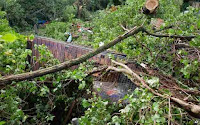About 28 500 homes have been left without power after Atlantic Storm Barny hit the UK and Ireland on Tuesday 17 November 2015. The majority of those affected were in the Republic of Ireland, were about 25 000 homes lost their power, with about 3000 homes without power in England, most of them in the Midlands, and about 500 homes in Wales.Transport networks were disrupted in both countries, as fallen trees blocked roads and railways and flights and ferries were cancelled as a safety precaution. In the UK the Environment Agency has issued flood warnings for parts of Sussex and Devon, as well as large areas of North Wales and Northern England. Storm damage has been reported in many areas, including Manchester where the roof of a block of flats collapsed, and Birmingham where damage to the Fort Shopping Park was recorded. Wind speeds in excess of 200 kilometers per hour were recorded in parts of Ireland, and in excess of 135 in parts of England, though these are gusts rather than sustained winds (wind speeds maintained for in excess of one minute). There have been several reports of injuries associated with the storm, but no fatalities at this time.
Damage to buildings and vehicles caused by high winds in Manchester, England. BBC.
Ocean
storms form due to heating of air over the sea in tropical zones. As
the air is heated the the air pressure drops and the air rises, causing
new air to rush in from outside the forming storm zone. If this zone is
sufficiently large, then it will be influenced by the Coriolis Effect,
which loosely speaking means the winds closer to the equator will be
faster than those further away, causing the storm to rotate, clockwise
in the northern hemisphere and anticlockwise in the southern hemisphere.
Flooding on the Dunkelin River in County Galway. Hany Marzouk/Irish Mirror.
Whilst the high winds associated these storms is extremely dangerous, the real danger from such storms is often the flooding. Each millibar drop in air pressure can lead to a 1 cm rise in sea level, and large storms can be accompanied by storm surges several meters high. This tends to be accompanied by high levels of rainfall, caused by water picked up by the storm while still at sea, which can lead to flooding, swollen rivers and landslides; which occur when waterlogged soils on hill slopes lose their cohesion and slump downwards, over whatever happens to be in their path.
Scaffolding brought down by Atlantic Storm Barney in Westminster, London. London Ambulance Service.
 'Hurricane' Niklas kills two in the UK and at least three in Germany. Atlantic Storm Niklas, which has caused flooding and widespread
disruption in the UK is reported to have reached hurricane force as it
swept onto the...
'Hurricane' Niklas kills two in the UK and at least three in Germany. Atlantic Storm Niklas, which has caused flooding and widespread
disruption in the UK is reported to have reached hurricane force as it
swept onto the... At least six dead as storms batter North Rhine-Westphalia. At least six people have died as storms battered the German state
of North Rhine-Westphalia on 9-10 June 2014. Two men and a woman were...
At least six dead as storms batter North Rhine-Westphalia. At least six people have died as storms battered the German state
of North Rhine-Westphalia on 9-10 June 2014. Two men and a woman were... At least six dead as Atlantic Storm hits Britain and France. At least six people have died after an Atlantic Storm hit Britain and
France on Monday 23 December 2013. Simon Martindale (48) drowned in the...
At least six dead as Atlantic Storm hits Britain and France. At least six people have died after an Atlantic Storm hit Britain and
France on Monday 23 December 2013. Simon Martindale (48) drowned in the...
Follow Sciency Thoughts on Facebook.



